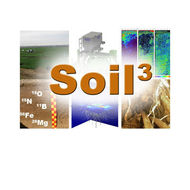Expansion and evaluation of two coupled root–shoot models in simulating CO <sub>2</sub> and H <sub>2</sub> O fluxes and growth of maize (2022)
Nguyen T., Langensiepen M., Hueging H., Gaiser T., Seidel S., Ewert F.
Vadose Zone Journal, (),
doi:10.1002/vzj2.20181
Abstract
Leaf water pressure head (Ψleaf) and more specifically its critical thresholds (Ψthreshold) characterize stomatal control of transpiration, particularly for C4 plants, but this physiological process has rarely been integrated into dynamic crop models at the field scale. We further extended two coupled models with Feddes root water uptake (RWU) and Couvreur RWU models by adding the C4 photosynthesis model in order to be applicable to a maize (Zea mays L.) crop growing under field conditions. The Feddes RWU model relates RWU and plant stress directly to the root zone water hydraulic potential, whereas the Couvreur model explicitly represents hydraulic signals between soil and stomata. Model performance was evaluated with a comprehensive dataset including stomatal conductance, Ψleaf, sap flow, gross assimilation rate (GAR), soil water content (SWC), dry biomass, and leaf area index (LAI) from a two-season maize experiment under contrasting environments and water regimes. For the Couvreur model, the RWU and dry biomass were more sensitive to the root hydraulic conductance parameters than to Ψthreshold and root growth parameters. The agreement index (I) for the Couvreur model after calibration was 0.91, 0.80, 0.81, and 0.69 for biomass, LAI, RWU, and GAR, respectively. The Feddes model performed similarly for the same metrics. The Feddes model simulated accurately the plant water stress in the first 45 d of the growing season, whereas the Couvreur model inaccurately predicted water stress, which resulted in lower agreement with observations (i.e., RMSEs of biomass simulated by Feddes and Couvreur model averaged from four validated plots were 0.171 and 0.214 kg m–2, respectively). The Feddes model showed the potential to be used for maize under water stress whereas the Couvreur model needs to be further evaluated and improved with an adequate estimation of root hydraulic conductance. A dynamic parameterization of normalized root system conductance and/or more accurate assimilate allocation to the roots, especially under drought stress, should be considered in order to apply this model in future studies to maize.


